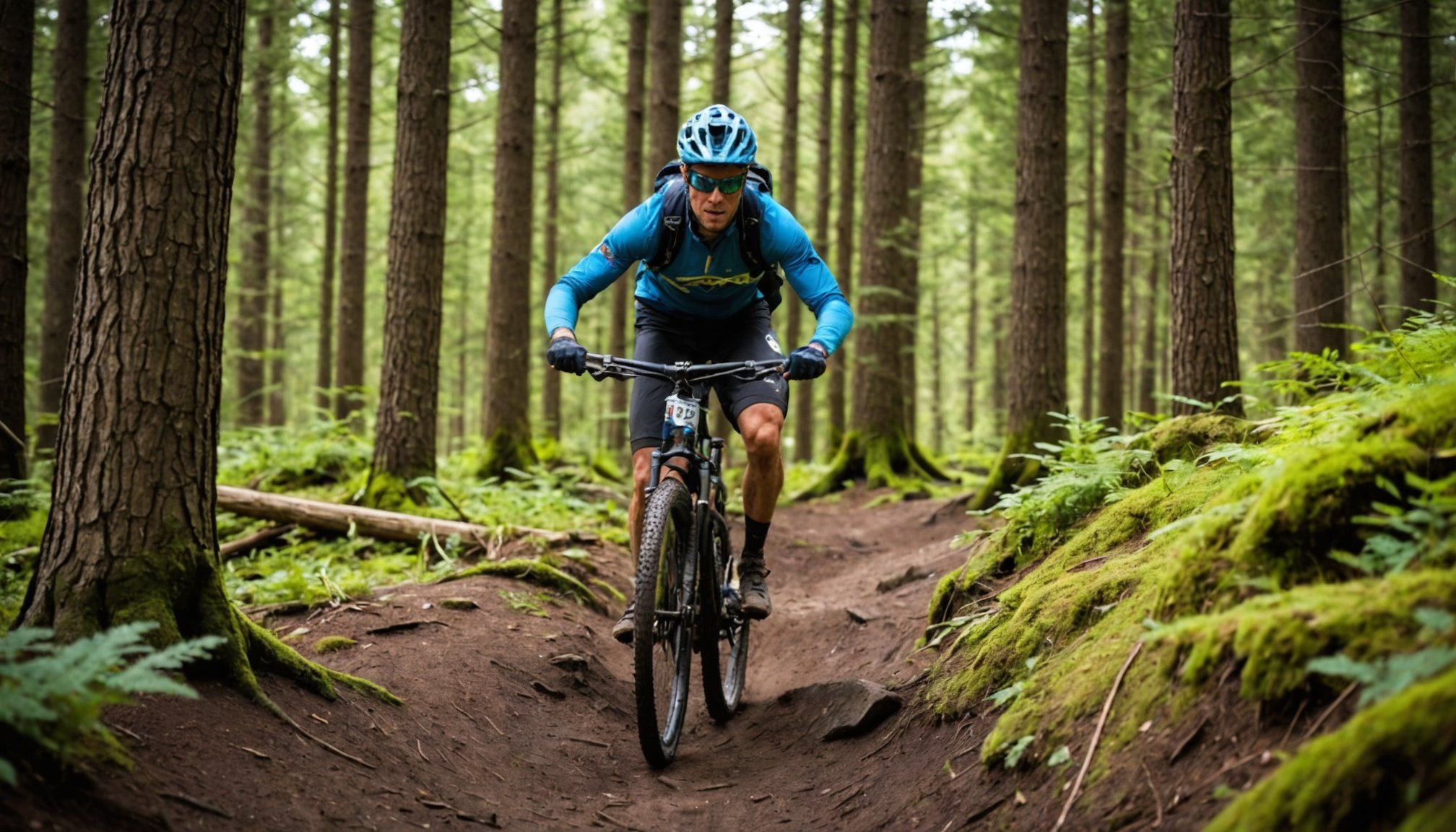Understanding Endurance and Strength in Mountain Biking
When navigating the rugged terrains of mountain biking, both endurance and strength are foundational to success. Each plays a critical role, yet they impact performance and training in distinct ways.
Endurance in mountain biking refers to the ability to sustain prolonged physical effort. It is crucial for maintaining energy levels during long rides and managing the physical strains of varying terrains. Typically, endurance training involves high-rep, low-weight exercises, and consistent cardiovascular workouts, which enhance the body’s oxygen efficiency and muscle stamina.
In the same genre : Crucial strategies for bowlers to reduce lower back pain risk: a comprehensive guide
Strength, on the other hand, is essential for maneuvering through challenging, steep, or rocky trails. It enables bikers to exert powerful bursts of energy, necessary for climbing hills or tackling obstacles. Strength training focuses more on high-weight, low-rep exercises aimed at building power, especially in the leg and core muscles.
The physiological factors such as the biker’s muscle fiber composition, aerobic capacity, and metabolic rate significantly influence performance. These components determine how effectively a rider can convert energy to motion, withstand fatigue, and recover post-training.
Also read : Elevate your golf performance: the definitive strength training blueprint for hitting longer drives
Differentiating between endurance and strength training helps bikers tailor their programs, balancing both aspects for overall improved performance. Understanding and optimizing these fundamentals elevate riding experience across diverse landscapes.
Essential Training Strategies
Improving performance in mountain biking demands a structured training regimen tailored to both strength enhancement and endurance. A well-rounded training schedule should incorporate robust strength training exercises that target key muscle groups utilized in riding. Exercises such as squats, lunges, and deadlifts are essential for strengthening the legs and core, fostering better stability and control while navigating uneven trails.
Incorporate biking workouts that build stamina and endurance. Tailor them to replicate trail conditions as closely as possible. Interval training can be particularly effective, with bursts of high-intensity exertion followed by recovery periods. For example, simulate climbs with uphill sprints and descents with steady downhill rides.
Creating a balanced training schedule is crucial for progressive improvement. It’s important to alternate between strength training and biking workouts, ensuring muscles recover properly while enhancing overall endurance. A typical week may include strength training on Mondays and Thursdays, and biking workouts on Tuesdays and Saturdays. This balance helps to prevent burnout and reduces the risk of injury, ultimately leading to sustained growth in riding capability and trail performance.
Nutrition for Performance
Achieving peak performance in mountain biking requires more than just skill—it demands a well-rounded nutrition plan. A balanced diet for athletes is fundamental for both endurance and strength development. It supplies the body with essential energy sources needed for rigorous rides.
Nutrition significantly impacts stamina. Carbohydrates, the primary fuel for muscles, should form the basis of an athlete’s diet. They provide the energy necessary for sustained exertion during long rides. Proteins are equally crucial as they contribute to muscle repair and growth, while healthy fats offer an additional energy source during prolonged activities.
Certain key nutrients and supplements can enhance performance. For instance, calcium and vitamin D strengthen bones, reducing injury risk on rough terrains. Meanwhile, supplements like electrolytes help maintain fluid balance, preventing dehydration.
Proper meal planning is also pivotal. Athletes should focus on timing their meals to ensure optimal energy levels. A balanced meal three to four hours before a ride is ideal, with a smaller snack 30 to 60 minutes prior. Additionally, hydration strategies are crucial. Drinking water steadily before, during, and after rides helps maintain performance and promotes recovery.
By focusing on these elements, mountain bikers can not only improve their endurance and strength but also enhance overall riding enjoyment.
Mental Strategies for Tough Terrain
Navigating tough terrain requires more than just physical skill; it demands robust mental toughness and resilience. To effectively harness these traits, cyclists can implement various psychological strategies.
One effective method is visualization. By picturing successful maneuvers over challenging obstacles, riders can mentally prepare themselves, reducing anxiety and stress on the trails. This can also enhance focus by providing clear mental images of the desired outcomes. Alongside visualization, practicing mindfulness during rides—such as focusing on breathing or the rhythm of pedalling—can keep distractions at bay and maintain concentration.
Establishing realistic goals is crucial for building mental resilience. Setting achievable targets encourages progress without overwhelming the cyclist, fostering a sense of accomplishment. Reflecting on these goals regularly reinforces the path towards improvement, allowing the rider to adjust strategies and maintain motivation.
It’s equally important to reframe failures not as setbacks, but as learning opportunities. Each experience, no matter how challenging, contributes to strengthening mental toughness. Riders develop resilience over time by adapting to varied conditions and pushing beyond mental barriers, ultimately enhancing overall performance.
Personal Testimonials and Case Studies
Listening to seasoned mountain bikers share their personal experiences is invaluable for anyone tackling tough terrains. These expert insights reveal that preparation and mental resilience are just as crucial as physical training. In one instance, a veteran biker recounted a harrowing ride across rocky trails, emphasizing the importance of adaptability and focus on the path ahead rather than obstacles.
Case studies provide more structured examples of effective training approaches. For instance, a group of enthusiasts documented a 12-week program focused on improving endurance and tackling steep inclines. Their findings highlighted that a combination of interval training, hill repeats, and recovery periods significantly improved performance. Participants not only boosted their stamina but also reported a psychological uplift, emphasizing the multifaceted benefits of structured training.
Expert interviews shed light on strategies for building both endurance and strength. Professionals recommend a mix of resistance training and aerobic exercises tailored to biking needs. They advocate for balance, suggesting that while endurance rides are vital, integrating strength sessions is equally crucial. By blending personal insights and systematic approaches, one can better prepare for the challenges and demands of mountain biking, ensuring a rewarding experience.
Visual Aids and Tools
Utilising visual aids and training tools can significantly enhance your biking experience. Leveraging training tools such as charts, videos, and apps is an effective way to track progress. They enable bikers to visualise improvements and set more precise goals. Performance tracking apps can log various metrics, such as speed, distance, and time, offering a comprehensive overview of your biking journey.
For those looking to boost their training, consider investing in recommended gear and equipment. For instance, GPS devices can provide real-time performance tracking, allowing bikers to adjust their pace or route as needed. Similarly, heart rate monitors offer insights into your cardiovascular performance, ensuring you’re training at the optimal intensity.
When it comes to utilising data, it’s crucial to focus on actionable insights. Analysing recorded data allows bikers to identify patterns and areas for improvement, such as adjusting cadence for efficiency or planning routes to suit current skill levels. By consistently reviewing performance metrics, bikers can fine-tune their training regimen effectively.
In essence, the strategic use of visual aids and technology can transform how bikers train, offering meaningful insights that propel their performance forward.
















